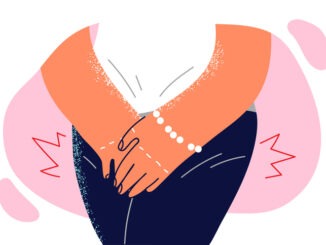
Practice Business recently attended Digital Health Rewired 2020. Caroline Criado Perez, author of award-winning book Invisible women: Exposing Data Bias in a World Designed for Men, spoke to entranced audiences about the terrifying ways in which healthcare fails to treat women with the same research-based rigor, and humanity, as men
Digital Health Rewired took place in March 2020. Stalls were abuzz with companies demonstrating their technological innovations and rooms were populated by impassioned speakers, imparting exciting predictions for the future of digital healthcare. However, one speaker, armed with a ground-breaking book, came to deliver a stark warning. Caroline Criado-Perez, armed with her non-fiction masterpiece Invisible women: Exposing Data Bias in a World Designed for Men, told her audience a story that goes back a millennium, which has permeated society to its core ever since. It is a story of how one half of the population is suffering a grave disservice – one that sometimes costs them their lives.
This story tells of gender data bias and how women are perceived as less important, less real and even less human than men and it is stitched through the history of healthcare. For example, in Ancient Greece, the philosopher Aristotle wrote extensively about how the female form was a kind of mutilated male body. He, as well as other philosophical contemporaries, believed female hysteria was caused by remaining celibate too long. The womb, grown irritable with lack of impregnation, was thought to ‘wander’ around the body, causing mayhem. The cure? To conceive a baby, whose weight would cause the womb to sink back down into its correct position. The womb was thought to be an animated creature in and of itself; one that was particularly unruly, that could only be tamed by men.
This incredible theory of ‘the wandering womb’ persisted well into the Renaissance. The female as ‘mutilated man’ theory persisted too. On anatomical drawings stemming from the period you can find medics trying to situate the female testicles. Indeed, they believed the female body was the male body turned inside out, and that females lacked ‘vital heat’ so their organs must be tucked away inside.
Caroline highlighted how this theory makes more sense the other way around – male sex organs hanging, as they do, unprotected and vulnerable outside the body – but this never struck the Renaissance medics; they had an unshakeable, patriarchal worldview to uphold. The female couldn’t possibly have a functioning, natural, unique pelvis all to herself – and so the quest was to map the ‘mutilated’ female form onto the anatomy of the man.
A story for our times?
So how is this story relevant in today’s western world, where inequality is, allegedly, being squeezed out of existence? Where women can vote, work, and are entitled to the same rights as men? Caroline asserts that we still operate under a patriarchal worldview – one ‘tucked away out of sight’, like the supposed female testicles.
She argues that this is prevalent in our modern healthcare system. It hides in our medical data – the data we collect through a lens that is systemically biased towards men. Her book powerfully unpacks the alarming medical statistics demonstrating that women are routinely under-represented in clinical trials, that periods are thought to obscure results, and that medical research proposed by women, for women, is not allotted the same funding as medical research proposed by men, for men.
Caroline is not alone in her concern; others, too, have pointed to gender data bias in technological medical innovation. Babylon Health’s ‘GP At Hand’, a smartphone app offering video consultations that currently serves as an NHS GP for over 50,000 UK patients, was called out for its disparity in treating men and women with the same symptoms.
If a patient types ‘chest pain’ into the GP At Hand app it will ask where the pain is located. If the patient selects ‘centre of chest’, they go on to be asked if the pain was sudden and whether it is accompanied by nausea. The patient will have to fill out some basic information about themselves – such as their age and whether they smoke.
But something drastic happens when they plug in their sex. A female patient, aged 59 who smokes, with central chest pain and nausea is told by the app that two possible causes of her symptoms are depression or a panic attack – which can be treated at home. A male patient with identical symptom history, age and background is also told he could be suffering from a panic attack. However, other causes offered to him are gastritis or even a heart attack; if he suspects the latter, he is advised to call an ambulance immediately.
Male data predominates
It is true that heart disease, on average, tends to strike men earlier than women. However, heart disease causes one-in-three deaths for both sexes, and is the leading cause of death in women as well as men. Alarmingly, more women have died of heart disease than men each year since 1984. This is partly explained by the fact that women, on average, live longer than men – but is it possible that something more insidious is occurring too?
The doctors behind the GP At Hand app insist that the app’s advice reflects up-to-date, rigorous medical data – but Caroline reveals that women made up only 25% of participants across 31 landmark clinical trials for congestive heart failure between 1987 and 2012. Heart disease data is, too often, predominantly male data. Is it really a surprise, then, that women are still 50% more likely to be misdiagnosed following a heart attack? Caroline believes that the GP At Hand app perpetuates a medical culture that does not take women as seriously as men, even if the brainpower behind it did so unconsciously.
So, what can be done to tackle a problem potentially so silent and systemic, so ingrained in mind and method, that it may be distorting what we regard so often as objective truth – our numbers? Caroline offers three possible solutions.
1. Collect sex-aggregated medical data: this means data are collected and analysed separately on both males and females.
2. Fix the models. Recruit women onto medical leadership and research teams. Caroline warns what can happen when women are excluded from decisions through the example of the Apple health tracker app, prized for its comprehensiveness. Patients can track their copper intakes, or the function of their molybdenums. They can not, however, track their periods. Perez stresses this was not caused by some misogynistic conspiracy against women by men – but simply a lack of female representation on Apple’s design team, causing them to forget that periods exist. It took them two years to fix this embarrassing oversight; (Caroline jokes that this is how long it took them to recruit a woman onto their team).
3. Take women seriously. Her parting words ask us to remember that “Men are not a standard that women fail to live up to”. For example, whilst researching the book, the excuses that ‘women are simply too complicated, the menstrual cycle will influence the results’ given by medical researchers caused her great concern. This line of thinking presents female bodies as complicating factors rather than bodies which represent 50% of humanity. The sentiment echoes the theory of Aristotle in Ancient Greece; that female bodies are but mutilated male ones, and that women are too unruly to be effectively studied.
Caroline argues that it is vital that this attitude is challenged and overhauled in order to avoid misdiagnosis and dehumanising swathes of the population – ‘male’ is not a default and there is still a long way to go in accurately anatomising, researching and diagnosing ‘invisible’ women.
Made curious by Caroline’s thesis, Practice Business’s next look at this issues explores how gender data bias might be present in general practice – and what practice managers might do to ensure that the women in their surgeries are better engaged, empowered, diagnosed and treated.
Don’t forget to follow us on Twitter, or connect with us on LinkedIn!



Be the first to comment